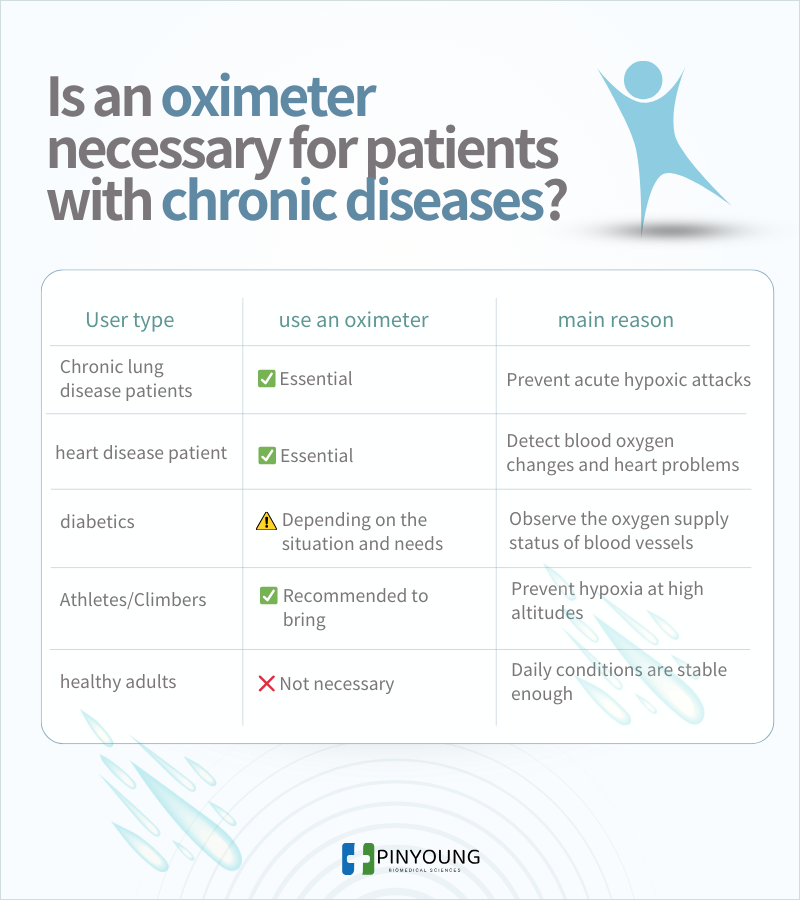Pulse Oximeter is a device that has been widely used in health monitoring in recent years. Especially after the COVID-19 epidemic, blood oxygen monitoring has become an important tool for family health management. However, does everyone need such a device? Is it a must-have, especially for patients with chronic diseases? This article will delve into which groups are suitable for using an oximeter, its functions and how to use it, and explain why patients with chronic diseases need to pay special attention to blood oxygen concentration.
What is an oximeter? How does it work?
OximeterIt is a non-invasive device that measures oxygen saturation (SpO2) in the blood and pulse rate. Clamped onto fingertips, earlobes or other parts, it uses infrared beams to penetrate tissue and measure changes in reflected light to determine blood oxygen concentration.
- normal blood oxygen concentration:95%-100%
- mild hypoxemia:90%-94%
- severe hypoxemia: Less than 90% (need immediate medical attention)
Groups suitable for blood oxygen machines
1. Chronic disease patients
- chronic lung disease(Such as COPD, asthma): Oxygen changes need to be monitored at any time to avoid acute attacks.
- cardiovascular disease: Low blood oxygen levels may be a sign that the heart is not pumping well.
- diabetics: Damage to blood vessels may affect the supply of oxygen to the blood.
2. People who have recovered from COVID-19 or high-risk groups
- In some patients, blood oxygen levels have decreased without symptoms, and blood oximetry can help with immediate detection.
3. Pregnant and fetal health monitoring
- Abnormal blood oxygen concentration during pregnancy may lead to fetal hypoxia, so regular testing is very important for pregnant women.
4. Athletes and alpine climbers
- After exercise and in high-altitude environments, a drop in blood oxygen concentration is a common phenomenon, and timely monitoring can avoid accidents.
5. elderly
- As age increases, respiratory function may gradually decline, and blood oxygen function becomes an important tool for daily health management.

The necessity of an oximeter: a chronic disease patient perspective
| disease | Reasons for blood oxygen monitoring | Recommended frequency of use |
|---|---|---|
| COPD/Asthma | Avoid acute hypoxia and prevent dyspnea | Once a day in the morning and evening |
| heart disease | Prevent insufficient heart pumping and detect the risk of hypoxemia | Test 1-2 times a day |
| diabetes | Observe blood oxygen supply status and prevent complications | Depends on medical needs |
| COVID-19 recovered persons | Track lung function recovery | Tested once a day |
| elderly | Prevent sudden hypoxia caused by respiratory function decline | 2-3 times a week |
How to choose the right oximeter?
- Measurement accuracy: Choose products with medical grade certification.
- display screen: Easy to read, very important especially for the elderly.
- Easy to carry: Lightweight design, suitable for carrying around.
- Bluetooth function: Can be connected to mobile APP for data recording and analysis.
Precautions when using an oximeter
- Correct position: Clip the device to your ring or middle finger for best readings.
- Avoid measuring immediately after exercise: Blood oxygen concentration may drop temporarily after exercise. It is recommended to sit quietly for a few minutes before measuring again.
- Avoid nail polish or cold hands: These factors will affect beam penetration and reduce measurement accuracy.
Conclusion: Is an oximeter necessary for patients with chronic diseases?
For patients with chronic illness, poor respiratory function, or cardiovascular disease, an oximeter is a valuable tool that can provide critical health indicators instantly and avoid worsening of the condition. Especially after the epidemic, the oximeter is not only a medical device, but also a part of family health management. Although the average person does not necessarily need to use it every day, among high-risk groups, the presence of a blood oxygen machine can greatly improve the sense of security.



